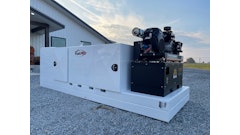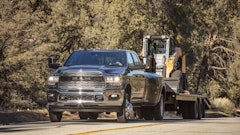
Transporting paving equipment has become a specialized industry for a lot of trailer manufacturers. In fact, many companies now offer models designed exclusively for hauling paving equipment.
"The days of building a trailer in the backyard are gone," says John DeGeorge, national sales manager, Eager Beaver Trailers. "Today, trailers are very high tech with air ride suspension, automatic ride height adjustment and ABS brakes."
One of the most identifiable characteristics of a paving trailer is its low load angle, which is often necessary for loading paving equipment due to low clearances and overhangs.
"A lot of paving equipment requires a low approach angle," says Rick Bodnar, sales manager, Load King Trailers. "Obstructions on the front of the machines prevent climbing at steep angles."
To accommodate those obstructions, paving trailers typically have less than a 12-degree loading angle, compared to about 18 to 22 degrees for a more traditional, general-purpose trailer. Some trailers currently on the market have ramps with load angles as low as 8 and 9 degrees.
Beyond a low load angle, there are several factors you will want to consider when spec'ing a trailer to haul your paving equipment. Manufacturers suggest you ask yourself the following questions.
How much weight will it carry?
Weight is one of the most influential aspects you will want to consider when spec'ing a trailer. "You need to start by understanding what you're going to haul," says Jim Ladner, national sales manager, Landoll. "This will allow you to purchase the right capacity trailer to handle the payload you want to move."
Consider all of the pieces of equipment you intend to haul. Be sure to include any rollers, brooms, grinders, etc. "People have a tendency to want to haul multiple pieces on a trailer," says Bret Jorgensen, district sales manager, Trail King. That's okay, he indicates, as long as you don't overload the trailer and push it over the legal weight limit.
This limit varies from state to state, so you need to know which route you plan to take, especially if you cross state borders. For example, Kansas has different weight limits than Missouri, and New Jersey has different limits than New York.
"If you undersize the trailer for the load, you can't permit it," says Bodnar. "Pennsylvania, for instance, will permit 52,000 pounds on two axles, whereas Tennessee will only permit 40,000 pounds on two axles."
A good starting point for determining weight limits is your local DOT permitting office. "It's also a good idea to periodically check the weight limits even if you think you know what they are," says Ladner. "Sometimes there are new regulations or changes that you might not be aware of."
Weight will also help determine which type of trailer is the best option for you. A tagalong trailer can typically accommodate up to about 25 tons. They're a good choice if you have smaller paving equipment, or if you only need to haul a single piece of equipment.
For moving multiple smaller pieces, some manufacturers offer extended decks. "Pavers, in relationship to cranes, excavators, etc., aren't that heavy," says DeGeorge. "With a dozer, you might have extra space for additional equipment, but it would be too heavy. Paving equipment isn't as heavy, so you can get multiple pieces of equipment on it if we stretch the deck length."
However, with larger-capacity tagalongs, make sure the towing vehicle is large enough to pull the intended weight. Undersizing the vehicle can compromise braking capabilities, as well as create handling issues.
Lowboy trailers can carry up to or more than double the amount of weight of the largest tagalongs. They are typically used by contractors with larger equipment, and those who want to haul multiple pieces of heavy equipment in a single load - one trailer, one tractor, one driver.
When sizing lowboys for your hauling needs, consider usable deck space between various models. Several models give you the ability to load rollers or brooms on deck space over the axles.
When comparing capacities of various trailers, be sure you're comparing apples to apples, advises DeGeorge. "You need to understand that there is a difference between payload capacity and GVWR (gross vehicle weight rating)," he says.
Payload capacity is strictly the weight of the payload. Trailer weight is already taken into account. For example, Eager Beaver lists its trailers by payload capacity. As such, its 35-ton model can carry 70,000 pounds plus the 18,000-pound trailer weight. Other manufacturers may list capacities as GVWR. In this scenario, a 35-ton trailer would be rated to carry 52,000 pounds, since you have to subtract the 18,000-pound weight of the trailer.
Also pay attention to the concentrated frame rating of the trailer, Ladner advises. Manufacturers vary in how they list this rating, as well. For example, some trailers are rated at 50,000 pounds per 10 feet of space vs. 50,000 pounds for 12 or 16 feet of space. The latter examples will, in reality, have less capacity.
It's also a good idea to know the component capacities of a trailer, Ladner adds. "Trailers are permitted on their weakest link," he says. "Let's say the axles and the suspension have a 25,000-pound capacity. But if the tires only have a 20,000-pound capacity, that's all you can get a permit for."
What are the load dimensions?
Although paving equipment does not tend to be as tall as other types of construction equipment, you still need to be aware of the load height. In most states, you need to keep load height under about 13 feet 6 inches, unless you obtain a special permit. Lowboy trailers tend to have an advantage over other types of paving trailers, since their decks are typically about 24 inches high, with some as low as 17 inches.
Tire selection can play a role in lowering deck height somewhat. "The whole key is to keep the deck height as low as possible," says Bodnar. "We do that by using a low-profile radial tire - a 215/75R17.5 tire with a 30-inch diameter."
Air ride systems available on many lowboys also help to keep deck heights low if all you need is an extra inch or two to fit underneath an overpass. "If you get to a bridge that's too low and you can't get under it, you can dump the air from the air bags on the trailer and sneak underneath," says DeGeorge. "Once you're through, then you can air them back up."
Load width is another consideration. Paving equipment used for driveways and small parking lots likely won't have any issues with width. But large machines may require the addition of outriggers to support any overhang on the trailer.
Also keep in mind future growth and how it may affect the size of the load and the trailer required. If you start with a small paver and roller, how long will it be before you upgrade to larger units? If you fail to plan ahead, you may find you need to upgrade your trailer, as well.
"One of the biggest things I see contractors overlook is that they don't plan for growth," says DeGeorge.
How often will you load/unload?
If you load and unload equipment frequently, you will want a trailer that simplifies the task. The biggest differences can be found between front- and rear-loading lowboys.
"Rear-loading trailers, such as our sliding axle models, are easier to load and unload pavers, rollers and brooms than a front-loading detachable gooseneck. You don't have to unhook the tractor, and they typically have very low load angles," says Jorgensen.
The advantage of a detachable gooseneck is it can usually handle a bit more weight, and it tends to be a little more versatile for hauling equipment other than pavers if you plan to use it for multiple purposes.
Many manufacturers have made detachables more user-friendly with the addition of hydraulics. "These are very forgiving," says Jorgensen. "You don't have to be perfectly lined up to connect the gooseneck."
Give it time
Determining the answers to all of these questions can take time. Yet, it's well worth the effort. While trailers don't directly add income to the bottom line, it doesn't mean they don't affect it.
"Spend quality time to match a trailer to your needs," encourages Ladner. "Without the trailer, you can't move large equipment to the jobsite. It's part of the team, so you should treat it that way."
Sakai SW320 Asphalt Roller
The SW320 double-drum vibratory asphalt roller delivers 4,000 vpm, allowing the option to increase ground speed while maintaining 10 to 12 impacts per foot spacing.
- 47-inch width
- Counter-rotational eccentric system promotes a smooth finish
- Dual drum drive
- 360-degree and drum edge visibility
- 21 1/2-inch curb clearance
- Standard ROPS folds down for working in height-confined spaces
Vögele Super 700 Paver
The Super 700 with electrically heated AB 200 V screed is able to drive through an opening less than 4 feet wide, pave within 2 inches of boundaries and drive in a 113-inch footprint.
- 57-hp Deutz BF3 M 2011 liquid-cooled diesel engine
- ECO Mode ensures sufficient power for all functions, but at a lower rpm for less fuel consumption, noise and wear
- 5.5-ton hydraulically operated hopper
- Basic paving width ranges from 3.6 to 6.5 feet with paving depths to 6 inches



















